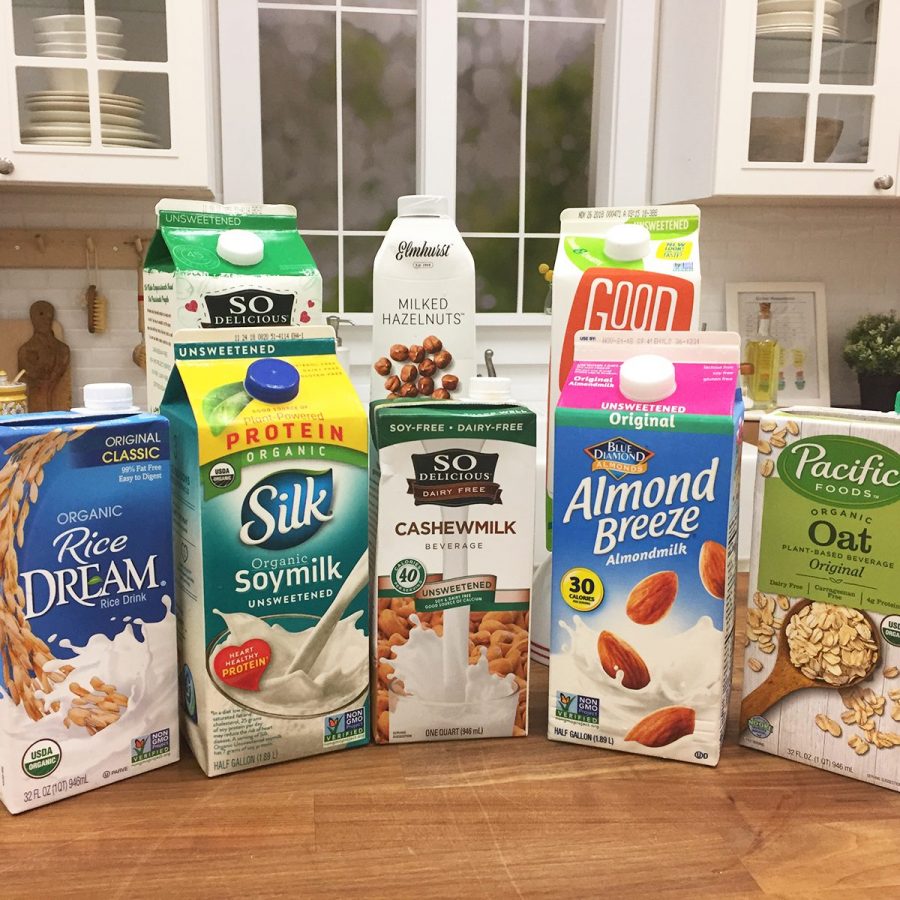Pro’s and Con’s of Different Plant-Based Milk Alternatives
March 3, 2021
None of the milk alternatives are going to taste the same as dairy would, but they will certainly come with less guilt. This huge movement away from dairy comes after revelations of the impact the dairy industry has on the environment.
Dairy milk production requires the most land, water, and produces the most CO2 emissions out of all milk options. The methane production from cows makes up 37% of total human activity emissions (Science Daily).
However, when looking for alternatives, not all plant-based milks are created equally. While under the guise of eco conscious creation, some still greatly contribute to the growing climate crisis.
Almond milk has the largest water consumption of all options at 371 litres of water per 1 litre of milk. While almost half as much as a litre of dairy milk, this number is still astronomical. The large water consumption of the almond industry, 10% of California’s water supply, has been linked to both the droughts and wildfires in the state.
Another issue linked to almond production is the recent honeybee genocide as almonds require the most pollinators by far. Between late 2018 and early 2019, 50 million honey bees were sent to pollinate almond crops that are routinely doused in lethal pesticides. About one-third of these bees were killed by the pesticides.
To almond milks defense: it releases comparatively low greenhouse gas emissions at 0.7 kg CO2 per litre of milk. This number does not include the emissions from the wildfires which are linked to the almond industry, but at a base level they are low.
As for the taste, almond milk is much skimmer than dairy milk, it tends to border a water-like thickness. Almond milk is also going to taste like almonds, there is no way around it. It is also not an option for those with nut allergies so it alienates many people.
Another option is Soy milk. Soy milk uses only 28 litres of water per litre of milk and produces only 1 kg CO2 per litre. However, the direct environmental impact of growing soya is huge.
Soya is primarily grown in the Amazon where growers contribute to mass deforestation and have been linked to fires in the Amazon for more room for crop. Deforestation, an issue of its own, is estimated to release about 4.8 billion tons of carbon dioxide annually, around 8-10% of the human annual emissions (Climate Council).
Nevertheless, Soy milk offers the most protein of any of the plant-based options. If grown in the US or Canada it is a relatively sustainable option. Soy milk is also most similar to real milk in texture and taste, but slightly more bitter.
Soy and almond milk typically have the lowest price points. These numbers will obviously differ slightly based on brand and grocer but all of the plant-based options tend to be around $3-4 per half gallon.
Rice milk is a similar option to almond milk in that it requires a fair amount of water at 270 litres per litre of milk. Rice milk also produces 1.2 kg CO2 per litre which is the highest of all the plant-based alternatives.
Coconut milk is a good option but only if it is labeled Fair Trade. Much of the production of coconut milk comes from the labor of exploited workers in Indonesia, the Philippines, and India. Coconut harvesting is also contributing to mass deforestation in these countries.
Both rice and coconut milk taste like what they are and are overall sweeter than dairy milk. Rice is a bit thinner than coconut milk. Rice milk production is less environmentally friendly but coconut milk has the chance of inhumane production.
Oat milk is one of the more sustainable options. Oats grow in temperate conditions, produced primarily in the US and Canada, and therefore are not linked to mass deforestation despite the large amount of land they need. Oat milk uses 48 litres of water, second to soy milk, and produces 0.9 kg CO2 per litre milk.
Oat milk production also falls victim to the heavy use of pesticides so when purchasing be sure the product is certified glyphosate free.
Oat milk has a very polarizing taste. It is slightly creamier than almond milk but can’t shake the graininess that comes from it literally being oats blended with water. To give it the benefit of the doubt though, oat milk is the newest of these options and needs time to be perfected.
All of these plant-based alternatives are going to be better for the environment than dairy milk, plain and simple. It is up to the consumer to choose if they value taste, cost, or environmental impact above the other factors.



